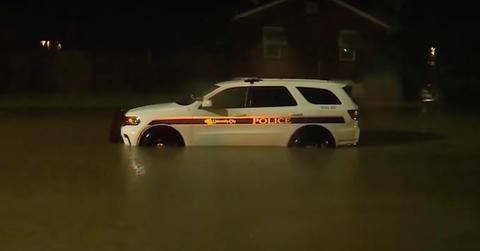Record-Breaking St. Louis Flash Flood Forces Home Evacuations by Boat
Published July 26 2022, 12:59 p.m. ET
UPDATE, July 27, 2022, 10:15 a.m. ET: The St. Louis flash flood has officially claimed at least one human life. AP News reported that one person was found dead after their car was covered by the floodwaters.
PREVIOUSLY, as published July 26, 2022, 12:59 p.m. ET: Overnight, a St. Louis flash flood has broken the record for most rainfall in the major Missouri city, prompting the National Weather Service St. Louis to issue a Flash Flood Warning.
The city was not prepared for a flood of this nature, and the heavy rain has already caused damage to homes, road closures, and forced people to need to be evacuated, as well as the death of some rescue puppies. Keep reading for the details on this flood, and a look into how climate change affects flooding.
St. Louis is dealing with a dangerous flash flood, which broke the city’s rainfall record.
A flash flood is a sudden and often unexpected flood, simply caused by heavy rain — and that’s exactly what happened in St. Louis, Mo. this week.
Tuesday morning, July 26, St. Louis residents woke up to 8.81 inches of rainfall, all of which came down between midnight and 9 a.m. on Tuesday, according to the The St. Louis Post-Dispatch.
This set a new record for rainfall in a single day in St. Louis. The previous record was set over a century ago, on August 20, 1915, with 6.85 inches of rain, as per ABC News.
And, as The Weather Channel noted, the rainfall is more than double the average rainfall St. Louis typically receives in the entire month of July each year — so the city was clearly not prepared for this sudden change.
This St. Louis flooding map shows which areas are most affected by the flash floods.
The National Weather Service promptly issued a Flash Flood Warning for the city of St. Louis and Saint Louis County (both located in east central Missouri), which will remain in effect until at least 11:45 a.m. CT.
As seen in a flooding map shared by the National Weather Service St. Louis, some of the cities affected by the flash floods are St. Louis, Chesterfield, and University City. According to the agency, the population of the affected areas is 987,132 — meaning that nearly 1 million residents are affected by this flood.
Missouri Governor Mike Parson advised affected Missourians to “continue to follow the safety messaging of local authorities.” Generally, those currently in affected areas should get themselves to higher ground as soon as possible, but avoid walking or driving through the flood — so rely on local emergency help if you are in need.
You can find a more detailed, up-to-date map of road closures on MoDOT’s website.
The St. Louis flash flood has led to road closures, people being stranded, and puppy deaths.
Since this much rainfall is extremely atypical for St. Louis, the city was not prepared with strong enough infrastructure to protect itself from flood damage. As roads and parking lots flooded, the rising water forced a number of road closures, and parts of interstates 170, 70, 55, and 64 had to shut down, as per The New York Times.
The City of Saint Charles, Mo. tweeted that flooding caused hillside erosion, ultimately causing the Frontier Park pedestrian bridge to collapse.
The floods left a number of people stranded in their homes, and the St. Louis Fire Department sent firefighters on inflatable boats to safely evacuate people. The department shared photos of people paddling inflatable boats and wading through several feet of water on residential streets, with cars in the background half-buried by the flood.
Stray Paws, an animal rescue group based in St. Peters, Mo., posted on Facebook at around 8 a.m. local time Monday morning that its building was flooding, and that the team was awaiting rescue teams to come evacuate animals. At 11:00 a.m., Stray Paws made an update to the post.
“Adult dogs are okay. Sadly the puppies did not make it, the water levels were too high,” the post now reads. “Fly high little ones.”
Additionally, at a St. Louis Zoo storage facility, there has been a partial roof collapse and potential leak of natural gas, as per ABC News.
What caused the St. Louis flash flood? Here’s how climate change comes in.
The National Weather service attributed the flash flooding to thunderstorms. As explained by the NWS, slow moving thunderstorms are actually the cause of most flash floods. And as added by Penn State, these slow thunderstorms can cause heavy rain to come down over a small area, at a pace too severe for the ground to absorb it, leading to a flash flood.
In general, there is a link between climate change and flooding. According to the UNEP, warmer temperatures allows the air to hold more moisture content and cloud formation, which means there can be more rain. The UNEP adds that as the climate crisis worsens, we can expect more extreme and frequent flooding in many parts of the world.
“While it is difficult to make a direct link between an individual extreme event and climate change, it is clear that we need to be prepared to face more intense and more frequent extreme hydro-meteorological events due to climate change,” stated Pascal Peduzzi of the UNEP.
This article has been updated.
